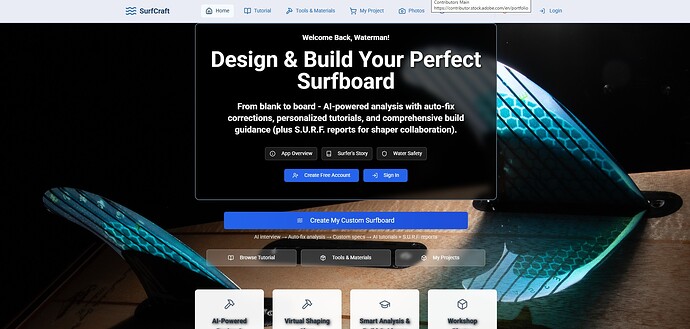Hey Swaylocks community,
I’m new to the site but wanted to offer something after building several boards. Its got a touch of my overly comprehensive approach but it’s pretty powerful if used (and operating correctly). I’m still working the beta version. Overall, it covers quite a bit. I’m tweaking the interface but need some inputs from the community. Your help would be greatly appreciated. Constructive criticism welcome. If your a social media cop, don’t worry about it. I’ll become familiar with the site (I should be having built boards) and come back to check replies/messages over time. (Happy to send a link to the App for anyone wanting to give it a try.)
Here’s my AI generated description of the site in its current form:
"A surfboard design platform that helps match surfers with their ideal board specs and provides comprehensive build guidance and AI generated tutorials for each phase of the build.
What makes it different:
• 16-question professional interview system that analyzes surfing level, wave conditions, and physical characteristics
• Physics-based wave analysis (0-3ft to 20ft+) with real paddle speed limitations research
• Intelligent auto-fix system that applies professional design principles to correct compatibility issues
• Performance-based fin selection (not experience-limited) - fins chosen for board type, wave size, and surfing goals
• S.U.R.F. report generation for shaper collaboration - complete specs in professional format
• Free AI tutorial generation that works with ChatGPT/Claude for detailed build instructions
• 41 authentic workshop photos documenting real builds with learning stories
The system uses industry-standard Guild Factor calculations and evaluates selections against professional surfboard design principles. When it detects issues (like a beginner trying to build a gun for 2ft waves), the auto-fix feature applies evidence-based corrections across 9 categories.
It serves both DIY builders wanting detailed tutorials and people working with professional shapers who need comprehensive specifications. The S.U.R.F. reports include calculated dimensions, rocker profiles, fin configurations, and complete user requirements.
Been testing it with various board types and wave conditions - the physics-based approach seems to align well with what we know about surfboard performance. The fin selection algorithm considers wave size, board design, and rider goals rather than artificial experience limitations.
Would be happy to share the link if anyone’s interested in checking it out or providing feedback. Always looking to improve the system based on real shaper knowledge and community input."
Cheers and Aloha!
John - Developer/shaper
P.S. The app emphasizes that building surfboards is a journey of learning and growth - it’s designed to guide and educate, not replace the hands-on experience and intuition that comes from working with foam and fiberglass.er)
SurfCraft
